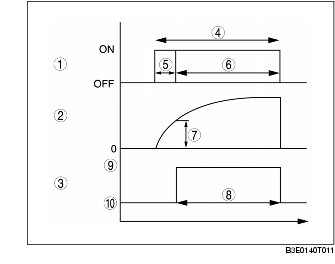|
Calculation and determination method for fuel injection time and correction
|
Control zone
|
|
|
|
|
|
|
|
Injection time at start
|
Set value according to engine coolant temperature (low engine coolant temperature→long injection time)
|
*
|
|
|
|
|
|
Basic injection time
|
Basic injection time = charging efficiency x fuel flow coefficient
|
|
*
|
*
|
|
|
|
Fuel cut
|
Fuel injection time = 0
|
|
|
|
*
|
*
|
|
Ineffective injection time
|
Set time according to injector performance
|
|
*
|
*
|
|
|
|
Volume increase correction at engine start
|
Purpose: Ensures engine speed stability just after engine start
Correction condition
• Specified time according to engine coolant temperature directly after engine start
Correction amount
• Low engine coolant temperature→large correction
• Low intake air temperature→large correction
|
x
|
x
|
|
|
|
|
Feedback correction
|
Purpose: Controls air/fuel ratio to theoretical air/fuel ratio
Correction condition
• Engine coolant temperature is at set value or more
Correction amount
• HO2S electromotive force is approx. 0.45 V or more→volume decrease correction
• HO2S electromotive force is approx. 0.45 V or less→volume increase correction
|
|
x
|
|
|
|
|
D-range correction
|
Purpose: Ensures engine speed stability during D-range shifting
Correction condition
• Throttle valve is fully open and shifting in D range
Correction amount
• Low engine coolant temperature→large correction
|
|
x
|
|
|
|
|
Heavy load volume increase correction
|
Purpose: Improved engine output, decrease of exhaust gas temperature
Correction condition
• According to engine speed when the throttle valve opening angle is the fixed value or more, otherwise, according to engine speed and charging efficiency
Correction amount
• High engine speed, high charging efficiency→large correction
|
|
|
x
|
|
|
|
Warm-up volume increase correction
|
Purpose: Ensures combustion stability when engine coolant temperature is low
Correction condition
• While at set engine coolant temperature
Correction amount
• High charging efficiency, low engine coolant temperature→large correction
|
x
|
x
|
x
|
|
|
|
A/C and P/S increase correction
|
Purpose: Ensures engine speed stability during A/C and P/S operation
Correction condition
• A/C or P/S operating
Correction amount
• Low engine coolant temperature→large correction
|
|
x
|
x
|
|
|
|
Volume increase correction during acceleration
|
Purpose: Corrects fuel injection delay during acceleration, to ensure drive stability
Correction condition
• When acceleration amount (change in the amount of charging efficiency) is at the set value or more.
Correction amount
• Low engine coolant temperature→large correction
• Large acceleration amount→large correction
|
|
x
|
x
|
|
|
|
Deceleration volume increase correction
|
Purpose: Ensures engine speed stability after fuel cut and fuel cut recovery
Correction condition
• When suddenly entering deceleration fuel cut zone while driving with load, or recovery from fuel cut, the correction value is gradually increased to the set value
Correction amount
• After meeting deceleration fuel cut condition→volume decrease correction
• During fuel cut recovery→volume increase correction
|
|
|
|
|
x
|
|
Learning correction
|
Purpose: Corrects deviation in air/fuel ratio from deterioration over time of mechanical devices
Correction condition
• Under any condition except purge control
Correction amount
• Learning value based on average of feedback correction value
|
|
x
|
x
|
|
|

